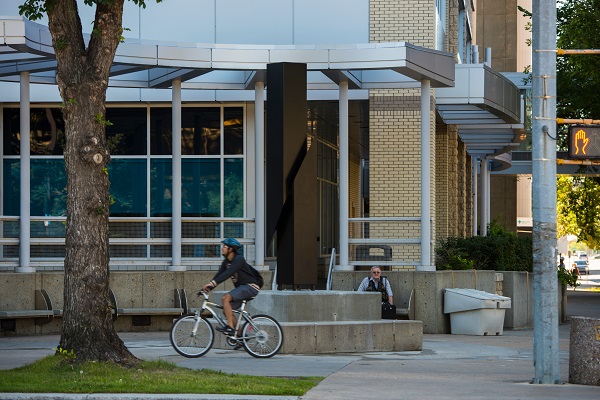
Signalos III, by Kosso Eloul (B. 1920 - D. 1995) is the latest impressive work of public art on the University of Alberta North Campus. It is located on the southeast corner of 114th street and 87th avenue and is a welcome addition to the University of Alberta's Art Collection.
Eloul is best known for creating large-scale, steel structures composed of rectangular forms balanced at unusual angles. Signalos III, at 12 feet tall, appears as though its two halves might slide apart, but Eloul has found the precise fixed-point at which they will remain stable. Signalos III speaks to the history of modern sculpture in Edmonton and at the University of Alberta.
There are two other versions of Signalos; one is located in Mexico City, Mexico which was commissioned by the by the Mexican ambassador in 1978 to commemorate the Mexican-Canadian friendship, and the other is in the Jewish Community Center's sculpture garden in Tucson, Arizona.
"When I chose the name Signalos , [the Mexican ambassador] told me that there is no such Mexican word." said Eloul in Celebrating with Sculpture: An Exhibition at the Royal Canadian Academy of Arts catalogue. "I was pleased to say, 'There is no such word in English, either. It's as abstract as the sculpture itself'."
Born in Murom, in the former Soviet Union, Kosso Eloul was raised in Israel, and educated in Tel Aviv and the United States, including at the Art Institute of Chicago and the Chicago School of Design. In 1969, Eloul settled permanently in Toronto, Ontario. An internationally renowned sculptor, Eloul was a key figure in the development of 20th century sculpture. He has more than 100 sculpture commissions across Canada and many more internationally - including the Canadian Embassy in Beijing, China. Arguably, his most well-known design is the eternal flame at Yad Vashem - the Holocaust memorial in Jerusalem, Israel which incorporates ashes from the victims of World War II concentration camps.
Signalos III was originally commissioned by an Edmontonian for a private residence in the city. The residence was then purchased by Dr. Fawzy and Mrs. Cornelia Morcos who generously donated the sculpture to the University of Alberta Museums Art Collection.
The late Dr. Fawzy Morcos was an associate professor in the University of Alberta's obstetrics and gynaecology department. He was awarded an honorary alumni award in 2014 for his many contributions to the University of Alberta. The entire Morcos family has a connection with the University of Alberta with seven degrees between Dr. Morcos, Mrs. Morcos and their four children.
Public art from the University of Alberta Art Collection inspires the future and preserves the past. Located throughout campus, public art creates a sense of place, documents the University of Alberta's distinguished history, is a creative source of pride for all of our communities, and reflects the importance of art in our daily lives.